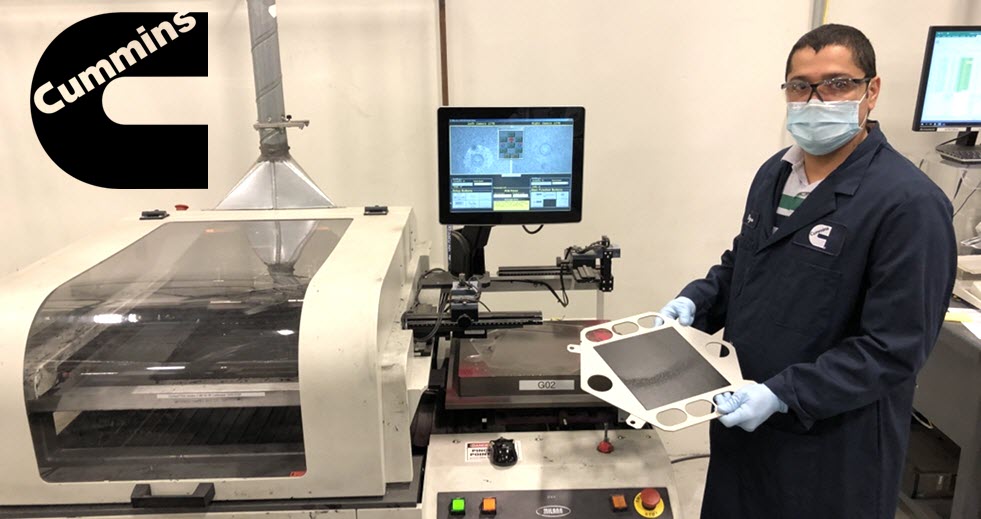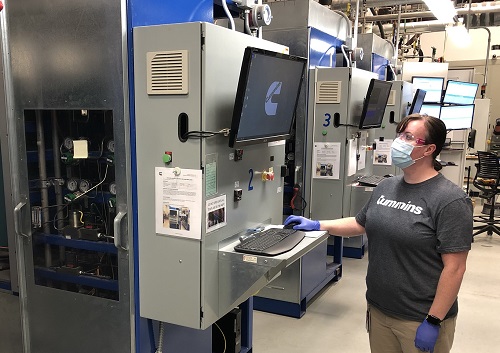
by Blair Claflin, Director of Sustainability Communications
Cummins is quickly becoming the leader in a power technology for commercial and industrial uses that could be an important bridge to a carbon-neutral future and beyond.
Solid oxide fuel cells (SOFCs) can convert a higher percentage of a fossil fuel’s energy into power than combustion-based processes and can also use low- and no-carbon fuels such as hydrogen to generate power.
The ability to do both, while producing far fewer heat-trapping gases and emissions than an internal combustion engine or a coal-burning power plant, is getting the technology plenty of attention recently.
“We need every tool we can get to address the world’s climate challenges and other environmental issues,” said Thad Ewald, Vice President of Corporate Strategy at Cummins. “Solid oxide fuel cells give our customers another way to achieve their environmental sustainability goals.”
Cummins has been awarded two federal grants totaling $4.6 million to advance the commercialization of SOFC technology through separate projects demonstrating both the technology’s ability to convert fossil fuels into energy, and its potential to generate hydrogen and convert it into the ultra-clean energy that will power the future.
SOFCs use a ceramic electrolyte to convert the energy in a fuel to power through a series of electrochemical reactions. With a continuous supply of fuel and oxygen, the fuel cells can be linked or stacked together to power a variety of applications.
They are viewed as especially promising for stationary applications. Unlike traditional sources of electricity, they don’t need to consume extra fuel to compensate for energy lost over long transmission lines.
Advocates, in fact, envision a day in the near future when SOFCs regularly power major energy users like data centers, effectively removing them from an increasingly over-burdened electrical grid.
THE POTENTIAL BRIDGE

A $2.6 million U.S. Department of Energy (DOE) grant will help Cummins build a 20 kilowatt (kW) small-scale SOFC power system at the University of Connecticut, fueled by natural gas but able to use multiple fuels.
The system will run 5,000 hours to demonstrate its durability.
That’s not a big enough SOFC system to power a data center but systems can be aggregated together to provide energy resiliency, security and availability, sufficient for not only data centers but other commercial and industrial applications and microgrids, too.
Cummins’ proposal calls for developing a system that would be available at a price point below $1,000/kW, with the flexibility and robustness for use in smaller and larger systems. The proposal says testing will begin in 2021.
THE PROMISE OF HYDROGEN
A second project funded with the help of a $2 million DOE grant will look at the cost, performance and reliability of a reversible fuel cell or R-SOFC.
It can run as a traditional SOFC or as a solid oxide electrolyzer cell (SOEC) that can split steam to separate hydrogen and oxygen.
This increases Cummins’ already market leading portfolio of electrolyzers to generate hydrogen, including Proton Exchange Membrane and alkaline technologies. The DOE grant proposal calls for building on a Cummins proprietary thermal spray technology to develop an advanced metal substrate or surface resulting in a 50% cost reduction by using less metal and cutting processing costs.
Cummins is quickly emerging as the leader in SOFCs for commercial and industrial power. The company’s novel spray technology, for example, enables Cummins to achieve larger cells, higher power densities, increased reliability and lower costs.
The company’s industry leading cell and stack size reduces system costs and complexity while providing a modular building block suitable for a variety of applications. Cummins also uses commodity stainless steel in its cells rather than more expensive and brittle ceramics used by some competitors.
Cummins’ work on SOFCs is consistent with PLANET 2050, the company’s environmental sustainability strategy adopted in 2019 to address climate change and other environmental issues. The strategy includes science-based goals aligned with the Paris Agreement to limit global temperature rise to no more than 1.5 degrees Celsius by the middle of the century.
Want to learn more about Cummins investments in SOFCs and other fuel cell technologies? Join company leaders including Chairman and CEO Tom Linebarger at 10:30 a.m. (EST) Nov. 16 for Cummins’ Hydrogen Day. Click here to register.
Read the most up to date Fuel Cell and Hydrogen Industry news at FuelCellsWorks




